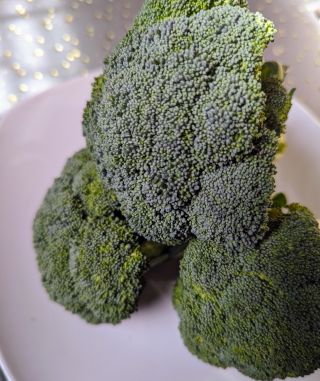Mindfulness
How to Encourage Our Kids to Eat Greens
Adventures in the kitchen with broccoli.
Posted April 19, 2024 Reviewed by Tyler Woods
Key points
- Eating mindfulness encourages our kids to build food awareness.
- Having ongoing conversations about food with our kids helps them develop a language around it.
- The magic of cooking broccoli is in the brighter green it turns once cooked.
- Once your kids try this recipe, they are certain to ask that more broccoli be brought to the table!

“Take the parsley off the pasta.”
“Take the basil off the pizza.”
These are some of the requests my chef husband, Julian, gets when parents at the restaurant order for their kids.
Requests that green things are gone things.
Understandable. We want our kids to eat. If there’s something they don’t like, it’s natural for us to adjust so food will be consumed.
Our 8-year-old son Olliver comes to mind. Olliver hates salad. He reminds us of this fact every time we eat it: “Yuck! Gross!”
The truth is, Olliver has never tried salad.
Not even once.
We beg, we bribe, we reason. “Olliver, how do you know you don’t like salad if you’ve never even tried it?”
He won’t budge.
But Olliver loves veggie sushi—the kind with avocado, carrots, and cucumbers. He loves it so much that when the chef of our favorite sushi place tells Olliver he can’t make it because they ran out of carrots, Olliver takes his uneaten carrots out of his lunchbox, handing them over for slicing and dicing.
Eating mindfulness encourages our kids to build food awareness. Hiding ingredients in food doesn’t allow them to make choices about what they’re eating. The risk is our kids don’t get to identify preferences, their likes and dislikes, related to healthy food choices.
The palate doesn’t develop, it gets controlled.
At some point, our kids grow up. If the healthy food’s been hidden, how do they know what to choose, or what they even like?
Julian often shares this story: Olliver used to love bananas. At age 3, he was eating three to four a day. It was wonderful, a healthy snack that was easy to pack up and take with us.
Then suddenly, at age 4, Olliver hated bananas. He completely stopped eating them. Nothing happened. He didn’t get sick. Olliver just decided he was done with bananas. Like the salad, he wouldn’t budge.
But Olliver loves Izzy’s Chocolate Banana Bread and is fully aware bananas are in it.
How do we understand when a certain food is liked in one way but not in another? Perhaps Olliver doesn’t like the texture of uncooked bananas. Their smell is also diluted in the banana bread.
Eating mindfulness recognizes we don’t just eat with taste, we can also eat with smell, touch, and vision.
How can we support eating mindfulness for our kids, encouraging them to make healthy food choices?

Ideas about these questions are in abundance. Today’s blog presents a few to consider:
- Have an ongoing, transparent conversation with our kids about healthy food choices. As parents, we know it’s important to talk about things like safety, reading, and doing homework. Isn’t it the same for food? In having ongoing conversations about food with our kids, we help them develop a language around it. They can share with us what they like, what they don’t like, or, like Olliver and bananas, how certain foods might work in some ways, but not in others.
- It’s normal that some foods our kids simply won’t like, just as we have food dislikes, too. It’s okay if our kids don’t like some foods; the same is true for us. Olliver refuses to try salad, but he loves broccoli. Mindfulness involves self-awareness. Through an understanding of food preferences, our kids become aware of what foods and food choices work for them. Our kids may cringe at the thought of one healthy food, but then gravitate to another.
- Food choices early in life influence healthy eating habits later in life. Ages 0 to 2, 5 to 7, and puberty are critical times for obesity prevention because there's a significant change in adiposity or body fat accumulation at these ages (Gato-Moreno, et al., 2021). Additionally, children’s eating behaviors are highly influenced by parent eating habits, with research suggesting that “parents should expose their offspring to a range of good food choices while acting as positive role models” (Scaglioni et al., 2018).
- Shopping, preparing, and sharing food builds eating mindfulness and connection. Since they were little, Julian took our kids grocery shopping. The downside was having to consistently say no to the many treats they wanted their dad to buy, although the limit setting might have set sugar management expectations. The upside was experiences like learning how to pick the best watermelon or seeing different kinds of vegetable roots. Bringing home broccoli ushered in an understanding of how foods change when sliced and cooked. The magic of cooking broccoli is in the brighter green it turns once cooked.
The connection surrounding the togetherness of cooking fosters eating mindfulness as a relational activity to be shared with those we love. As you make broccoli with your little one, consider the research: you are the food model. In this spirit, let’s begin by acknowledging the beauty of the color green—embodied in a stem of broccoli.
In our book Eating Together Being Together we talk about how broccoli is often overlooked, a reflection of not being cooked the right way: crunchy when not cooked enough, mushy when left to cook too long.

But we can find the “al dente” balance (e.g., firm to the bite) right at the start of our broccoli journey.
Recipe
Top Tip: When you shop for broccoli, only choose a stem that is bright green and firm. Your little one can help you explore the broccoli florets in the search to pick just the right one.
Top Tip: This healthy recipe only requires three ingredients. Easy peasy.
BROCCOLI
Ingredients
2 pounds fresh broccoli
1/4 cup unsalted butter
fine sea salt
SERVES 4
The way you prepare your broccoli can maximize flavor from the start. As described in our book (Clauss-Ehlers & Clauss-Ehlers, 2022), “Cut bite-size florets from the stem. You do not need to waste the stem. For a longer stem, remove and discard the final inch.
Peel the rest of the skin on the broccoli with a peeler and cut it into 1/2-inch pieces. Then add to be cooked with the florets. When you have a shorter broccoli stem, just incorporate with the florets. Wash your broccoli in fresh, cold water, and drain.
Meanwhile, fill a large pot with about 5 quarts of water (there are 4 cups in a quart, so use 20 cups of water) and bring to a boil. Once the water is boiling, add 5 teaspoons of fine sea salt and return to a boil.
Top Tip: When you add the salt, the water may stop boiling because salty water boils at a slightly higher temperature. Because of this, you want to make sure that your water is boiling when you add the broccoli.
After checking to make sure your water is boiling again, add your broccoli—the water will stop boiling—cover immediately, and return to a boil. Once your water is boiling again (this could take about 30 seconds), immediately remove the lid. Cook your broccoli, uncovered, for 3 minutes.
That’s it! Immediately drain your broccoli and place it in a bowl. Melt the butter in a small saucepan or the microwave. Pour the melted butter over the broccoli and toss. Finish it with a few pinches of sea salt."
Once your kids try this recipe, they are certain to ask that more broccoli be brought to the table!
References
Clauss-Ehlers, J.C.E., & Clauss-Ehlers, C.S. (2022). Eating together being together: Recipes, activities, and advice from a chef dad and psychologist mom. Princeton Architectural Press.
Gato-Moreno, M., Martos-Lirio, M. F., Leiva-Gea, I., Bernal-López, M. R., Vegas-Toro, F., Fernández-Tenreiro, M. C., & López-Siguero, J. P. (2021). Early nutritional education in the prevention of childhood obesity. International journal of environmental research and public health, 18(12), 6569. https://doi.org/10.3390/ijerph18126569.
Scaglioni, S., De Cosmi, V., Ciappolino, V., Parazzini, F., Brambilla, P., & Agostoni, C. (2018). Factors influencing children's eating behaviours. Nutrients, 10(6), 706. https://doi.org/10.3390/nu10060706




